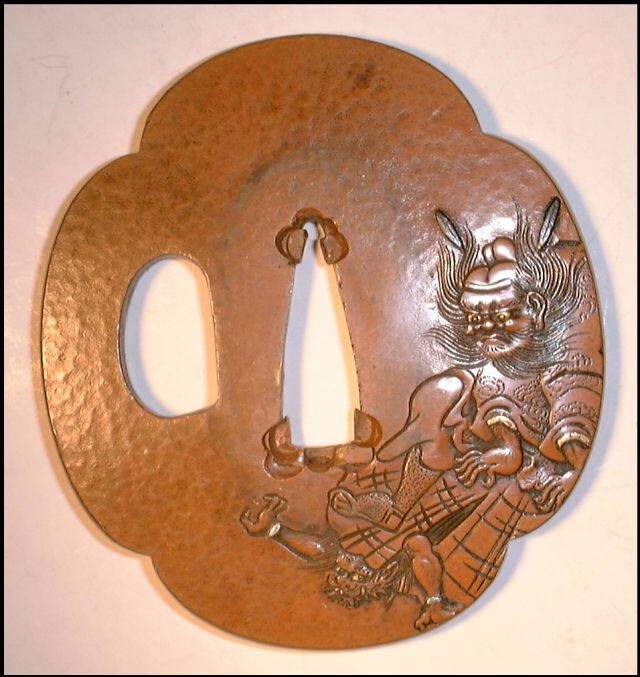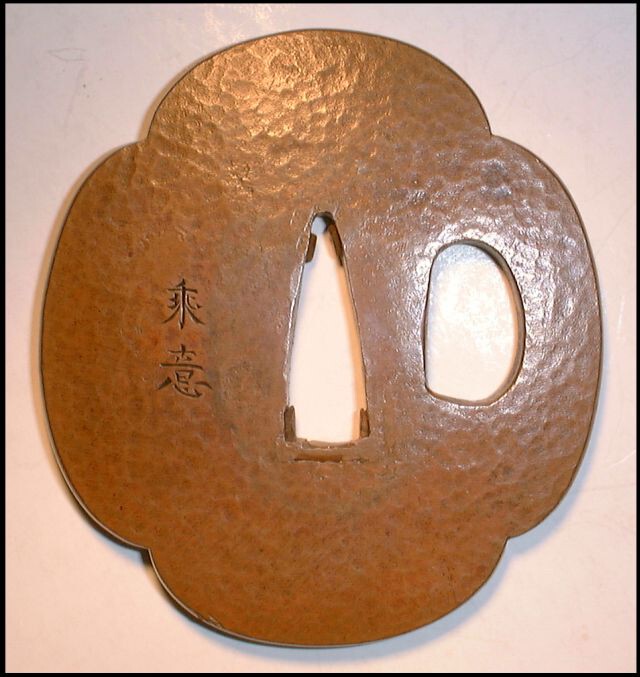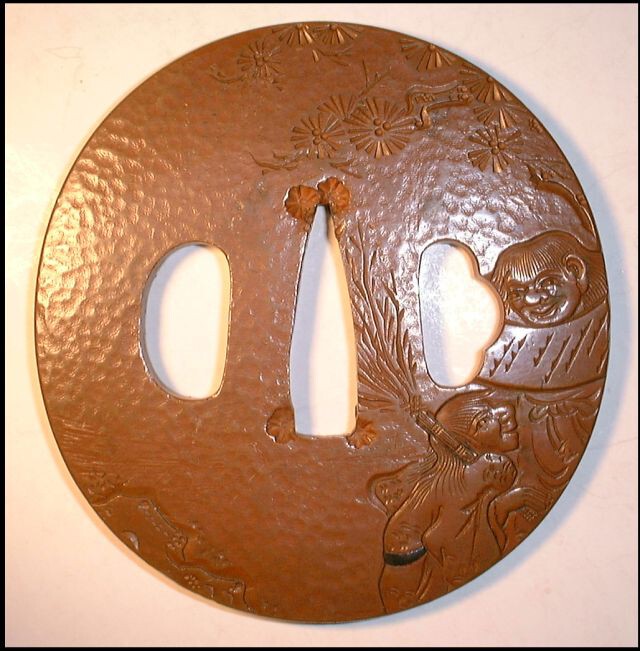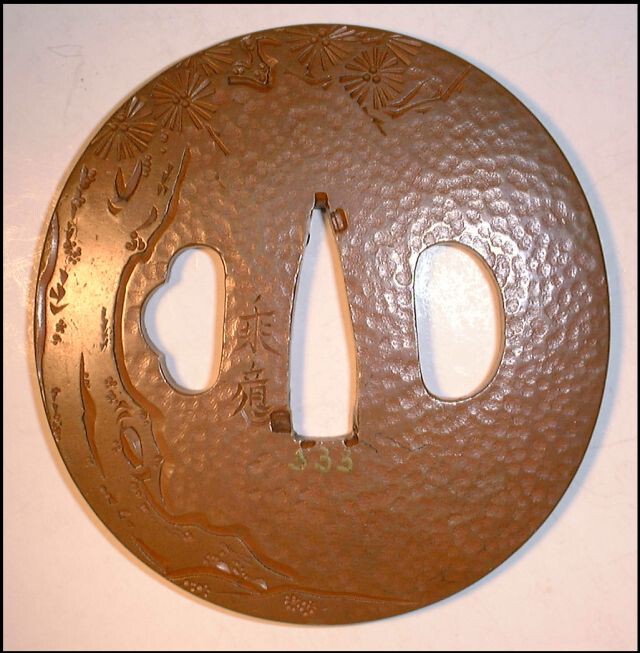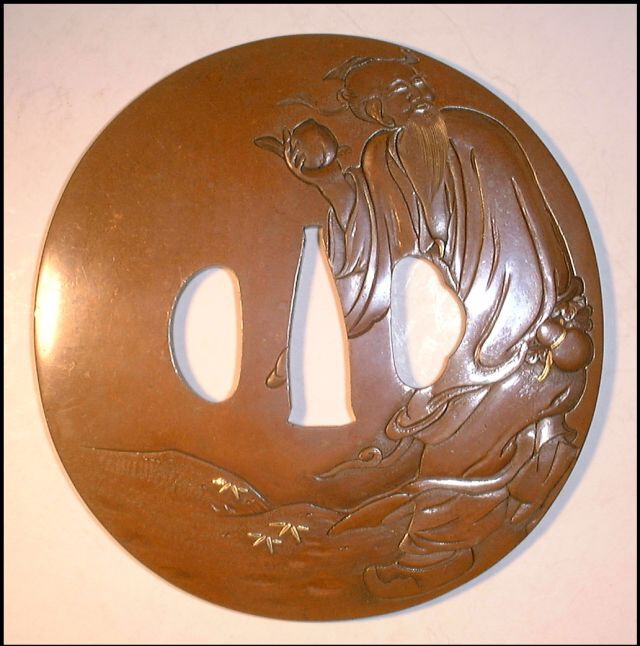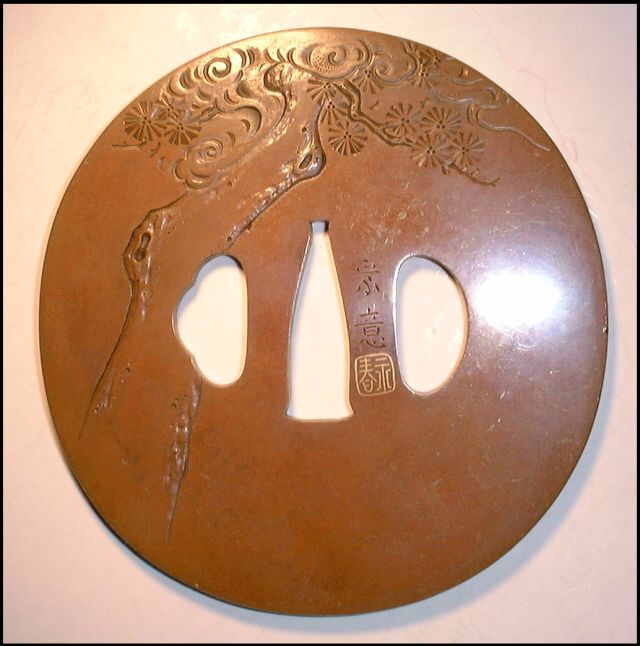-
Posts
815 -
Joined
-
Last visited
-
Days Won
1
Content Type
Profiles
Forums
Events
Store
Downloads
Gallery
Everything posted by docliss
-
Interestingly, we now have access to five tsuba, each with identical inserts of the Omi Hakkei, rendered in copper and with a silver plating, in an iron plate. These are: 1. A tsuba in my own collection, and illustrated in the thread viewtopic.php?f=2&t=2636 as noted above by Bob M. 2. Also illustrated in the same thread, Steve refers to a tsuba with similar inserts, but with a raised mimi, and with a NTHK paper attributing it (questionably?) to the Ichijō group. 3. On p.93 of Inami Tomohike’s Catalogue of the Fahrenhorst Collection is illustrated a very similar tsuba that is attributed to Satō Yoshiteru (H 12173.0), 1828-1902, and working in Kyotō. 4. On p.113 of the sale catalogue of the Collection du Docteur Mène is another tsuba. The illustration shows only three decorative inserts on the omote surface, and the gold hon-zōgan decoration present on the other tsuba appears to be absent here; it is described as having a seal for Tōu present on the ura surface. Is it conceivable that this is in fact a seal for Tōhō, a Satō artist (H 09713.0), 1824-1859, and working in Kyotō? 5. Finally that of Ludolf, with identical inserts on a (supposedly) Kaneie II plate. These tsuba raise two questions in my mind. Is there a common origin to all of them? The images were clearly ‘mass produced’, and were probably generally available for tsubakō to obtain, but was a single school of artists responsible for the end product? And were the ‘views’ silvered by a yakitsuke process, using a silver/mercury amalgam, or by an electroplating method, bearing in mind that electroplating with the noble metals was not perfected in the West until the 1840s? John L.
-
Ludolf, with all due respecr, are you seriously suggesting that 'deckungsgleich' is a sound basis for the attribution of a tsuba? Given a group of tsuba, accepted as being all by the same hand, I wonder how many of these would pass this test. John L.
-
Dear Ludolf The consistent shape of each 'view' indicates that these decorative plaques were 'mass produced', presumably in the C19; I should, therefore, be very surprised if those on your tsuba are not, as are the others, silver plate on a copper disc. I think that the suggestion that your tsuba is the dai-tsuba of a dai-sho pair explains very neatly the presence of only four of the classical eight views. Why do you so confidently call the plate of your tsuba a 'kaneie II' plate? Kind regards, John L.
-
With my thanks to Ford and Henry for their contributions, I remain puzzled by some attributions to the Katchūshi group. Why, for example, has the attached tsuba been described by Jim Gilbert as ‘today it would probably be attributed to Katchushi’, and by Robert Haynes as ‘Katchushi in Ko-Shoami style – ca 1500’? Yes, it has a kaku-koniku mimi, and a thin plate (2.25 mm), but why …. John L.
-
Come on guys – can nobody explain to me the basis upon which some tsuba are presently being labelled by cogniscenti such as Robert Haynes and various shinsa panels as ‘katchūshi’, while bearing little obvious similarity to this group as described in the literature? John L.
-
May I ask what is the present understanding of the label ‘katchūshi tsuba’? The original meaning of ‘armour-makers’ tsuba’ quite clearly no longer applies to later work, and neither do the earlier characteristics of thin, ita-tsuba with ko-sukashi decoration and kaku mimi. What, then, is a katchūshi tsuba? John L.
-
No Brian, I cannot claim to be the originator of the Tempo chart, and I regret that I am also unable to acknowledge its creator since I cannot recall from whence I downloaded it. My apologies to whoever it may be. John L.
-
Is not the stamp on David's tsuba that for 'kotobuki' - one of the recurring kokuin on Tempo tsuba? John L.
-
I am an admirer of James’ tsuba. Late Edo work, surely, in a lovely, rich hiirodo. The second kanji is indeed HIRA, as Chris states, but I am less convinced by his TSUGU reading of the first kanji, which is very unclear. And, surely, this is not swordsmith’s work, as he suggests. I agree that to mount this tsuba, with seppa, would not be easy, although Colin’s suggestion is a possibility. In fact, the tsuba shows no indication of ever having been mounted - this would be very apparent since the peaks of the seppa-dai would be very prone to wear. As a final thought, can one create a true mokume surface on a soft metal alloy? I suspect that, in this instance, the surface has been carved, but would value Ford’s comments on this. John L.
-
John’s tsuba demonstrates a strong namban influence, and is an interesting variation on that group normally identified with Hirado Kunishige work. These latter tsuba are normally of brass, tate-maru-gata and with a square, raised rim; some are of iron, however, and they are normally signed. The Roman letters stamped around the edge are described as ‘meaningless and used solely as a decoration’, and the recognition by Ian, Marc and Christian that those on John’s example have a relevance is a very interesting one. John L.
-
Dear Steve I believe that the kanji on your tsuba read SHOAMI. It is probably C19 Aizu Shoami work, an attribution that is supported by the nature of the iron plate and by the wide ryo-hitsu. Regards, John L.
-
Dear John, Is that not MASATOSHI with kao? Haynes lists four artists of this name using the seven-stroke kanji for ‘toshi’, but none using this combination with the fourteen-stroke one. The Baur catalogue lists Tsuchiya Toshimasa, with the mei illustrated on #623, and notes that he sometimes reversed these kanji. But the illustrated kao is quite unlike that on yours. Can one assume, therefore, that this is work by a skilful but unlisted artist of that name, working in the C19? Incidentally, is your fuchi nanako-ji? Regards, John L.
-
Peter’s mokkō-gata tsuba is certainly an example of Mino kinkō work, but is unusual in its apparent lack of any gold decoration. Examination of the images suggests that there may be traces of this remaining on the shakudō plate; or is this one of those unusual examples that are devoid of any such decoration? Regards, John L
-
Dear Marc By my understanding, gilding is 'the covering or overlay with gold or with any goldlike substance'. Thus all of the various methods utilised by the Japanese to achieve this end, including nunome-zogan, are included under this descriptive term. Whether or not this also includes inlay I am not sure ... probably not. Kind regards, John L.
-
Ford, in reply to your query re the dating of the auriculate tsuba, I suppose that 'second half of the seventeenth century' is about as close as we can get. Regards, John L.
-
Dear George Thank you for your informed comments upon the Dutch East India Company. While it is not my wish to subvert Ford’s thread, I should like to observe that the presence of the kozuka-hitsu on this guard confirms that it was intended for mounting on a Japanese blade, and its position confirms that the image has not been reversed. The ‘reversed’ VOC logo is unlikely to have been produced by stamping – surely such a stamp would not have been incorrectly produced – but rather engraved by a worker unfamiliar with Western characters. I believe that such tsuba were possibly produced both in Japan and also in India for export to Japan. John L.
-
Firstly, may I compliment Ford on his careful selection of images for posting? Each is an ideal example of the school/period that it represents, and even I begin to see where the discussion on aesthetics is leading. But I still dislike the term ‘Japanese aesthetics’. It is the art that is Japanese; the aesthetics are personal, and mine alone, even if they have been given neat, Japanese labels. In reply to his query regarding the dating of the two tsuba in part IV, I am somewhat surprised by the 1600-1640 period given to the Hizen tsuba. It is published on pp.46-7 of Graham Gemmell’s Tosōgu: Treasure of the Samurai, and is influenced by the Portuguese tooled leather that was indeed introduced into Japan in the seventeenth century. But I personally prefer GG’s dating of the mid-eighteenth century for the tsuba, and would like to hear Ford’s reasons for his earlier preference. Ford obviously recognises that the dating of auriculate Namban tsuba is a hobby-horse of mine. Published on pp.50-1 of Syz’s Masterpieces from the Randolph B Caldwell Collection: Japanese Sword Fittings, this is a beautiful example of this fascinating group of tsuba, and bears the VOC logo of the Dutch East India Company. Japanese shinsa panels appear always to date these as Momoyama period, and this I take issue with. These tsuba are said to be based upon the style of Iberian sword guards. But the swords that were introduced into Japan during the Momoyama period were rapiers, with their increasingly elaborate hilts, and the absence of any solid, discoid guard. This is evidenced by the reproduction of these curlique guards on Japanese six-fold screens of the period. The small sword, used purely for thrusting and furnished with a discoid counter-guard, had gradually evolved as a replacement for the rapier by the third decade of the seventeenth century. It is probably this later counter-guard, consisting of simple elliptical plates or of two conjoined shells, that influenced the development of the auriculate guard. Two additional features on these guards add to the doubts regarding their Momoyama dating: • The presence of a diminutive, kebori VOC logo on the seppadai of some of these guards suggests that many of them were made by the Dutch East India Company. While this company had a presence in Japan from the early seventeenth century, its exclusive trading rights were not established until 1639, in the early Edo period. • Many of these guards demonstrate a decorative feature identified as ‘swan-neck drawer handles’. It is not certain whether these are derived from European swan-neck furniture handles, or are a later, abstract interpretation of the mokkō design. But these handles do not feature in Western brass trade catalogues until the 1730-80s — well into the late Edo period. I thus conclude that the auriculate sub-section of Namban guards should be dated as of the Edo rather than the Momoyama period. John L.
-
Ford, it is not the use of aesthetics about which I express my dislike. Rather is it the constant repetition of the phrase 'Japanese aesthetic' as a form of mantra, and used to express a concept which the user, in his imagination, wrongly attributes as being unique to the Japanese. John L.
-
Oh dear, are we back to 'aesthetics' again? John L.
-
Dear Ford In answer to your interesting question, I believe that a Western influence on Japanese tosōgu may be considered to manifest itself in three possible ways. (a) The use of Western subject matter • Christian motifs, including Ikenie tsuba and those incorporating the cross. • Western objects, including Black Ships, figures in bizarre Western dress, and the inclusion of a VOC logo in the design. • Random Western letters and numerals, as seen in the work of Hirado Kunishige. (b) The idiosyncratic depiction of Japanese subjects • Many examples may be seen of works which fail to depict their subjects in the ‘Japanese way’; these may include the improper depiction of objects, and the use of perspective. • One such, particularly interesting, example of this group was seen by the author on a C19 Aizu Shōami tsuba that depicted the Shinnen festival. One of the streamers had fallen from the shimenawa, and was lying on the floor. But the space left by it on the straw rope was depicted as though the inlay had become detached from the plate. © Atypical metalworking techniques You yourself are ideally suited to expand on this group, but ishime depicting the texture of Portuguese tooled leather, and auriculate guards, modelled upon the counter-guards of Western small swords, are two examples of this group. Those are my thoughts on the subject …. Regards, John L.
-
Dear Hamish Your newly acquired tsuba is an iron, solid plate tsuba depicting, in low relief, maple leaves floating upon water. This is a populat theme in Japanese art, and may represent the Tatsuta river near Nara, described by the poet Narihira as being ‘Chinese deep-scarlet’ with the fallen leaves. The design also appears to include several water drops, depicted in gold ten-zōgan. I agree that this is probably C19 work, and is by either a Chōshū or a Bushū worker; my inclination is to favour the former. John L.
-
Dear Jon, I am sorry to see that you have not yet received a reply to your recent posting, but am sure that this is partly due to the very poor quality of the images that you have posted. Please try again .... John L.
-
-
Dear Ludolf I reply to your query not as an ‘expert’ but as an ‘interested party’. On p. 189c of the earlier edition of Kinkō Meikan is an illustration of a Joi mei with a seal identical to the one you illustrate. This seal is described by the author as reading Nagaharu. What, then, do the seals on your ‘real Joi pieces’ read, with their additional, and varying, character? The only other Joi seal that I have seen is that illustrated in Shōsankenshu, and described by the author as ‘early’. This is on a rather fine gimei tsuba of which I am attaching an image; I imagine this to be a Meiji work by a Mito Sekijōken artist. Regards, John L.
-
Following Dave’s previous posting of a (?)Nara tsuba, have any members remarked a recurring feature on both Ko-Nara and later Nara tsuba? Quite often the landscapes of these include, on one or other surface, a small rock formation that is remarkably consistent in its structure, and I am attaching several images to demonstrate this. While its presence may not be considered to be a ‘defining characteristic’ of the group – although I note that Dave’s tsuba also included such an element – I wonder if any member has an explanation for this. Does it occur in any of the Japanese legends, or is it a geographical feature of the region? John L.





